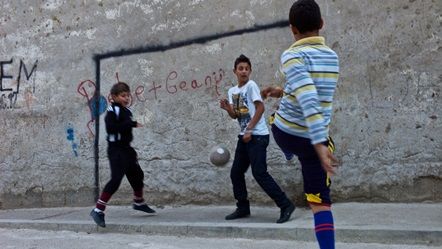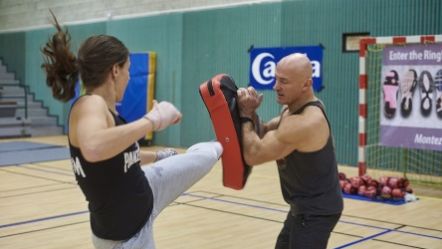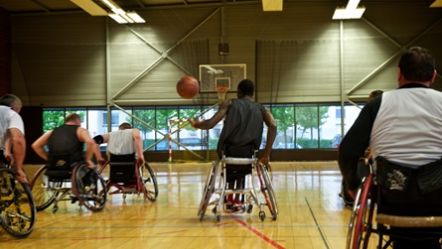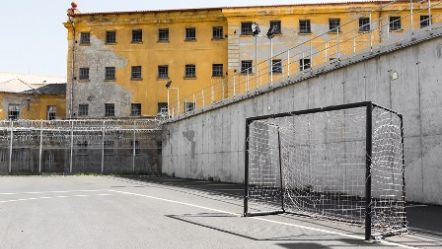Inclusive sport
Promoting diversity has been a permanent priority of EPAS since its foundation in 2007, as the principle of diversity is an important value and a backbone to all the work of the Council of Europe. The rights and freedoms of all citizens of the member states of the Council of Europe together with the prohibition of discrimination are anchored in the European Convention on Human Rights on which the normative framework of the Council of Europe in the field of sport is based. Via projects and events, EPAS has already addressed topical issues in sport related to gender, race, ethnicity, physical and intellectual ability, sexual orientation, migration, prisons and many others.

Migrants and their integration through sport

In the context of one of the most significant migration crises, the Council of Europe has a major role to play. With sports being commonly considered as a precious tool for the integration of migrants, the Enlarged Partial Agreement on Sport (EPAS) organised an annual conference on this issue in Vienna in June 2016.
Following on from this, EPAS has set up an interactive platform intended for all stakeholders working in this field, all professionals and volunteers as well as organisations seeking information on the topic and wishing to swap their practices and ideas.
This online platform not only lists actions and projects in the field of migrants and their integration through sport but also lists project owners. Finally this platform contains a forum with restricted access.
In order to implement this tool and fuel the developing network, the project owners are encouraged to fill in the form provided either in English or in French to present their work and to spread this information as widely as possible!
EPAS is also a dissemination partner in the ASPIRE project being implemented by ENGSO.

Gender equality and gender mainstreaming

In spite of the progress and the existence of standards at national, regional and international level earmarking the principle of equality between women and men and the right for everyone to participate in sporting activities, a gap between norms and reality still exists, and the discriminations towards women and girls, especially those who come from disadvantaged groups, are still apparent.
Today, inequalities still persist in sport, encompassing a variety of areas like: access to sport, education and physical activities; participation at the governing and decision-making bodies; access to resources, to remuneration, to financial incentives and sports facilities; media representation of female athletes and women’s sport; gender-based violence, including harassment and abuse.
For many years, the Enlarged Partial Agreement on Sport (EPAS) of the Council of Europe has addressed this problem with a view to obtaining equality between women and men in sport. It kickstarted its activities on this subject with an annual conference in London on 15-18 September 2011.
Among the most important achievements, we can highlight:
 The good practice handbook: “Gender equality in sport. Women’s and girls’ access to sporting activities.”
The good practice handbook: “Gender equality in sport. Women’s and girls’ access to sporting activities.”
The first part of this handbook presents the existing situation on girls’ and women’s participation in sporting activities in Europe: their access, their obstacles and their activities. Good practices and successful experiences throughout Europe are gathered in a second part. As for the last part, it puts forward a set of recommendations, originating from the analysis of the good practices, whose purpose is to help practitioners and policy makers in pushing forward the fight for gender equality in sport.
 The Committee of Ministers’ recommendation to the member states on gender mainstreaming in sport (CM/Rec (2015) 2)
The Committee of Ministers’ recommendation to the member states on gender mainstreaming in sport (CM/Rec (2015) 2)
This recommendation works on the assumption that in order to rectify the structural nature of inequality between women and men in sport, it is necessary not only to adopt positive measures but also a gender mainstreaming strategy engaging all the institutions and actors involved in its implementation. In this way, it encourages member states to review their legislation in order to include gender mainstreaming in the policies and sport public programs and sports education.
 A seminar on the implementation of gender mainstreaming in sport (co-organised by EPAS and European Women and Sport (EWS)) on the 17 November 2015
A seminar on the implementation of gender mainstreaming in sport (co-organised by EPAS and European Women and Sport (EWS)) on the 17 November 2015
The public authorities’ and sport organisations’ representatives present at this seminar were able to benefit from useful guidance in order to implement policies on gender mainstreaming in sport.
 Two joint projects (European Union/Council of Europe): “Balance in sport. Tools to implement gender equality” (2016) and "ALL IN – Towards gender balance in sport" (2018-2019)
Two joint projects (European Union/Council of Europe): “Balance in sport. Tools to implement gender equality” (2016) and "ALL IN – Towards gender balance in sport" (2018-2019)
"Balance in Sport", implemented in partnership with a range of partners (Ministries in charge of sport, sport organisations, European Union agencies, networks, etc.) set out to identify and test common indicators to measure the equality between women and men in sport. Different dimensions were studied: access to positions of greater responsibility; training; practice of a sport activity; (from grassroots sport to elite sport), media representation of female athletes and women’s sport, as well as gender-based violence. A pilot data collection campaign was carried out in Spain, Finland, France and Romania in order to collect information on gender equality in sport in Europe based on a common methodology.
This is being followed by a 2nd joint project "ALL IN – Towards gender balance in sport" which aims at implementing a broad data collection campaign on gender equality in sport based on a set of generally agreed indicators in five strategic fields (leadership, coaching, participation, media / communication and gender-based violence), and producing concrete tools to help public authorities and sport organisations when developing policies and strategic actions aimed at tackling gender inequalities in sport, and adopting a gender mainstreaming approach. 18 countries took part in the data collection process, and the results can be found here.
Link to the Council of Europe's Gender Equality website
 Conference: Breaking the cycle of inequality in sport (Zagreb, 25 October 2018)
Conference: Breaking the cycle of inequality in sport (Zagreb, 25 October 2018)
A conference entitled “Breaking the cycle of inequality in sport - by fixing gender balance in leadership and preventing violence against women” was held in Zagreb on 25 October 2018, organised by the Enlarged Partial Agreement on Sport, under the Croatian Chairmanship of the Committee of Ministers of the Council of Europe. This conference addressed research evidence and policy responses in order to increase women’s leadership and to eliminate all forms of violence against women in sport.

Disability sport

Since the 1960s, the Council of Europe has developed recommendations and resolutions guaranteeing full participation of disabled persons into social and sport life.
The challenge is a considerable one: that everyone – both able-bodied and disabled – be allowed to benefit from the advantages of practising sport. For those with motor, intellectual, mental or sensory disabilities, practising sport not only covers the therapeutic and medical intentions generally defined as treatment, but also the social and educational aspects.
In 2011, EPAS focused on this theme during a regional seminar in Warsaw on 17-18 January 2011, which it co-organised with the Ministry of Sport and Tourism of Poland, and the European Paralympic Committee, on “Disability Sport as an active tool to overcome discrimination and to promote social inclusion”.
EPAS continued to pursue its activities on disability sport by supporting training and awareness-raising events (most notably, a project with CAFE which ran training seminars so that audio-descriptive commentary was available at every match of the Euro 2012 tournament for blind and partially sighted supporters inside the eight host stadiums).
In its Good Practice collection, EPAS also published a handbook on disability sport in Europe.
Tackling homophobia in sport
The fight against homophobia is everyone’s responsibility. At the Council of Europe, the objective of this fight is two-fold: on the one hand, to promote and ensure respect for the human rights and dignity of every individual, including lesbians, gays, bisexuals and transgender persons (LGBT), and to combat discrimination and violence against them on the other.
There is no room in European sport for violence and discrimination against LGBT persons. In conformity with European sports policy standards adopted within the Council of Europe (European Sports Charter, revised in 2001, and the Code of Sports Ethics, revised in 2010), discrimination will not be tolerated when it comes to sports activities or access to sports facilities. These texts comply with the universalist approach by recognising everyone’s right to participate in sport.
In 2012, EPAS chose tackling homophobia in sport as its diversity theme, and co-organised a conference in Utrecht (Netherlands) entitled “United against homophobia in sports: the contribution of policy-makers, researchers and sports movements”, with support from the European Gay & Lesbian Sport Federation (EGLSF). The aim of the conference was to take stock of the overall situation regarding homophobia and transphobia in and through sport, to look at activities and projects being run by the various parties and to see their impact, in particular, on young people.
To follow up the success of this conference, EPAS published a good practice handbook containing practical and concrete examples of projects that show commitment by Council of Europe member states in their fight against homophobia in sport, and which hope to inspire others to do the same.

Physical Education teaching

Sport and physical education are important tools to raise future generations in the spirit of the core values promoted by the Council of Europe such as democracy, human rights and respect for rules.
Participation per se in physical education and sport does not necessarily facilitate an ethical development in children and youth. Physical educators and sport coaches need to organize young people’s experiences of games and activities in such a way as to make the ethical dimensions of sport explicit. In co-operation with the Council of Europe’s Pestalozzi programme 20 training resources were developed to promote the Council of Europe values in sport and physical education.
As a follow-up to these training resources, EPAS organised its annual conference in 2015 on the subject of “Tolerance and Diversity through Physical Education and Sport”, which was held in Bled, Slovenia, on 19-20 November 2015.
In 2016, EPAS commissioned the drafting of a good practice handbook on inclusive and innovative approaches to physical education, which will summarise the work done following the Pestalozzi training units and give recommendations on how teaching physical education can help transfer skills learned to everyday life, as part of civic activities that can lead to social change. The handbook was published mid-2018.
Link to the 20 training resources produced by the Pestalozzi Programme.

Sport and Prisons in Europe

As part of its activities to promote diversity in and through sport, EPAS decided to concentrate its actions in 2014 on the role of sport in prisons.
In order to prepare the ground for the 2014 annual conference on this topic, it first of all organised an expert seminar on 5 March 2013, in co-operation with the Council for Penological Cooperation (PC-CP) and und the Andorran Chairmanship of the Committee of Ministers, to bring together experts from both the penitentiary and sporting authorities in Europe.
Free to play documentary (by the “Prisoners on the move” project)
The following year, the EPAS annual conference took place at the French National Olympic and Sports Committee headquarters in Paris, and a variety of good practice examples were showcased over the two days.
The next step taken by EPAS was to proceed with a publication containing the analysed results of a questionnaire and the best practices identified during the conference, in order to provide Council of Europe member states with a set of criteria which would allow them to evaluate, assess and plan specific (existing or future) sport in prison projects, as well as to present a set of good practice examples illustrating this.




